| Me 262 Schwalbe | |
|---|---|
 |
|
| Messerschmitt Me 262A | |
| Role | Fighter aircraft |
| Manufacturer | Messerschmitt |
| First flight | 18 April 1941 with piston engine 18 July 1942 with jet engines[1] |
| Introduction | April 1944[2][3] |
| Retired | 1945, Germany 1951, Czechoslovakia[4] |
| Primary users | Luftwaffe Czechoslovak Air Force (S-92) |
| Number built | 1,430 |
The Me 262 was often mistaken by observers for the Gloster Meteor, the first allied jet fighter aircraft, due to similarities in their appearance, leading to numerous friendly fire incidents on both sides. While German use of the aircraft ended with the close of the Second World War, a small number were operated by the Czechoslovak Air Force until 1951. Captured Me 262 were studied and flight tested by the major powers, and ultimately influenced the designs of a number of post-war aircraft such as the North American F-86 Sabre and Boeing B-47 Stratojet.[7] A number of aircraft have survived on static display in museums, there have also been several privately-built flying recreations.
Contents
Design and development
Origins
Several years before World War II, the Germans foresaw the great potential for aircraft that used the jet engine, constructed by Hans Joachim Pabst von Ohain in 1936. After the successful test flights of the first jet of the world, the Heinkel He 178, they adopted the jet engine for an advanced fighter aircraft. As a result, the Me 262 was already under development as Projekt 1065 (P.1065) before the start of World War II.Plans were first drawn up in April 1939, and the original design was very similar to the aircraft that eventually entered service. The progression of the original design was delayed greatly by technical issues involving the new jet engine. Funding for the jet engine program was also initially lacking as many high-ranking officials thought the war could easily be won with conventional aircraft.[11] Among those were Hermann Göring, head of the Luftwaffe, who cut the engine development program to just 35 engineers in February 1940; Willy Messerschmitt, who desired to maintain mass production of the piston-powered Bf 109 and the projected Me 209; and Major General Adolf Galland, who supported Messerschmitt through the early development years, flying the Me 262 himself on 22 April 1943. By that time, problems with engine development had slowed production of the aircraft considerably. One particularly acute problem arose with the lack of an alloy with a melting point high enough to endure the high temperatures involved, a problem that by the end of the war had not been adequately resolved.[11]
In mid-1943, Adolf Hitler envisioned the Me 262 as an offensive ground-attack/bomber rather than a defensive interceptor. The configuration of a high-speed, light-payload Schnellbomber ("fast bomber") was intended to penetrate enemy airspace during the expected Allied invasion of France. His edict resulted in the development of (and concentration on) the Sturmvogel variant. It is debatable to what extent Hitler's interference extended the delay in bringing the Schwalbe into operation.[16][17] Albert Speer, then Minister of Armaments and War Production, claimed in his memoirs that Hitler originally had blocked mass production of the Me 262 before agreeing in early 1944. He rejected arguments that the aircraft would be more effective as a fighter against the Allied bombers that were destroying large parts of Germany, and wanted it as a bomber for revenge attacks. According to Speer, Hitler felt its superior speed compared to other fighters of the era meant it could not be attacked, and so preferred it for high altitude straight flying.[18]
Although the Me 262 is often referred to as a "swept wing" design, the production Me 262 had a leading edge sweep of only 18.5°, too slight to achieve any significant advantage in increasing the critical Mach number.[19] Sweep was added after the initial design of the aircraft, when the engines proved to be heavier than originally expected, primarily to position the center of lift properly relative to the center of mass. On 1 March 1940, instead of moving the wing backward on its mount, the outer wing was repositioned slightly aft; the trailing edge of the midsection of the wing remained unswept.[20] Based on data from the AVA Göttingen and wind tunnel results, the middle section's leading edge was later swept to the same angle as the outer panels.[21]
Test flights
The first test flights began on 18 April 1941, with the Me 262 V1 example, bearing its Stammkennzeichen radio code letters of PC+UA, but since its intended BMW 003 turbojets were not ready for fitting, a conventional Junkers Jumo 210 engine was mounted in the V1 prototype's nose, driving a propeller, to test the Me 262 V1 airframe. When the BMW 003 engines were installed, the Jumo was retained for safety, which proved wise as both 003s failed during the first flight and the pilot had to land using the nose-mounted engine alone.[1]
This airframe, Wrknr. 111711, was the first Me 262 to come into
Allied hands when its test pilot defected in March 1945. It was
subsequently lost in August 1946, the US test pilot parachuting to
safety.[22]
On the second attempt, Wendel solved the problem by tapping the aircraft's brakes at takeoff speed, lifting the horizontal tail out of the wing's turbulence.[24] The first four prototypes (V1-V4) were built with this configuration. Changing to a tricycle arrangement (initially a fixed undercarriage on the fifth prototype (V5), with fully retractable on V6 (with Stammkennzeichen code VI+AA) and subsequent aircraft) corrected this problem.[Notes 2]
Test flights continued over the next year, but engine problems continued to plague the project, the Jumo 004 being only marginally more reliable than the BMW 003. Airframe modifications were complete by 1942 but, hampered by the lack of engines, serial production did not begin until 1944, and deliveries were low, with 28 Me 262s in June, 59 in July, but only 20 in August.[7] This delay in engine availability was in part due to the shortage of strategic materials, especially metals and alloys able to handle the extreme temperatures produced by the jet engine.[citation needed]
Even when the engines were completed, they had an expected operational lifetime of approximately 50 continuous flight hours; most 004s lasted just 12 hours, even with adequate maintenance. A pilot familiar with the Me 262 and its engines could expect approximately 20–25 hours of life from the 004s. Changing a 004 engine was intended to require three hours, but this typically took eight to nine due to poorly made parts and inadequate training of ground crews.[citation needed] With one engine out, the Me 262 still flew well, with speeds of 450–500 km/h (280–310 mph; 240–270 kn), but pilots were warned never to fly slower than 300 km/h (190 mph; 160 kn) on one engine, as the asymmetrical thrust would cause serious handling problems.[citation needed]
Due to the high speed jet stream, turbojet engines develop much less thrust at low speed than propeller powered aircraft, resulting in poor low-speed acceleration. This was particularly noticeable in the Me 262, since early jet engines had relatively low power and responded slowly to throttle changes. The introduction of a primitive autothrottle late in the war helped only slightly.[citation needed] Conversely, the superior power of jet engines at higher speeds meant the Me 262 enjoyed a much greater rate of climb. Used tactically, this gave the jet fighter an even larger speed advantage in climb than in level flight at top speed.[citation needed]
Operationally, carrying 2,000 l (440 imp gal; 530 US gal) of fuel in two 900 l (200 imp gal; 240 US gal) tanks, one each fore and aft the cockpit, and a 200 l (44 imp gal; 53 US gal) tank beneath,[Notes 3] the Me 262 would have a total flight endurance of 60 to 90 minutes. Fuel was usually brown coal-derived J2, with the option of diesel oil or a mixture of oil and high octane B4 aviation petrol.[26] Consumption was double the rate of typical twin-engine fighter aircraft of the era which led to the installation of a low-fuel warning indicator in the cockpit to notify pilots when the remaining fuel fell below 250 l (55 imp gal; 66 US gal).[26]
Unit cost for an Me 262 airframe, less engines, armament, and electronics, was RM87,400.[27][Notes 4] To build one airframe took around 6,400 man-hours.[27]
Operational history
Introduction
On 19 April 1944, Erprobungskommando 262 was formed at Lechfeld just south of Augsburg, as a test unit (Jäger Erprobungskommando Thierfelder, commanded by Hauptmann Werner Thierfelder)[3][29] to introduce the 262 into service and train a core of pilots to fly it. On 26 July 1944, Leutnant Alfred Schreiber with the 262 A-1a W.Nr. 130 017 damaged a Mosquito reconnaissance aircraft of No. 540 Squadron RAF PR Squadron, which was allegedly lost in a crash upon landing at an air base in Italy.[30] Other sources state the aircraft was damaged during evasive manoeuvres and escaped.[31]It was the first victory for a turbojet fighter aircraft in aviation history.[32] Major Walter Nowotny was assigned as commander after the death of Thierfelder in July 1944, and the unit redesignated Kommando Nowotny. Essentially a trials and development unit, it holds the distinction of having mounted the world's first jet fighter operations. Trials continued slowly, with initial operational missions against the Allies in August 1944 allegedly downing 19 Allied aircraft for six Me 262s lost, although these claims have never been verified by cross-checking with USAAF records. The RAF Museum holds no intelligence reports of RAF aircraft engaging in combat with Me 262s in August, although there is a report of an unarmed encounter between an Me 262 and a Mosquito.[33]
Despite orders to stay grounded, Nowotny chose to fly a mission against an enemy bomber formation flying some 30,000 feet above, on 8 November 1944. He claimed two P-51Ds destroyed before suffering engine failure at high altitude.[34] Then, while diving and trying desperately to restart his engines, he was attacked by other Mustangs, and forced to bail out. Historians Morgan and Weal proposed Nowotny's victor was P-51D pilot Lt. Robert W. Stevens of the 364th Fighter Group.[35] The exact circumstances surrounding the death of Walter Nowotny remain uncertain to this day. It is also possible he was hit by "friendly" flak.[35][36] The Kommando was then withdrawn for further training and a revision of combat tactics to optimise the 262's strengths.[citation needed]
During March, Me 262 fighter units were able, for the first time, to mount large scale attacks on Allied bomber formations. On 18 March 1945, 37 Me 262s of JG 7 intercepted a force of 1,221 bombers and 632 escorting fighters. They shot down 12 bombers and one fighter for the loss of three Me 262s. Although a 4:1 ratio was exactly what the Luftwaffe would have needed to make an impact on the war, the absolute scale of their success was minor, as it represented only one per cent of the attacking force. In 1943 and early 1944, regardless of the presence of the small numbers of Me 262s, the USAAF was able to keep up offensive operations at loss ratios of roughly 5%.[citation needed]
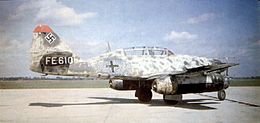
Me 262B-1a/U1 night fighter, Wrknr. 110306, with Neptun radar
antenna on the nose and second seat for a radar operator. This airframe
was surrendered to the RAF at Schleswig in May 1945 and taken to the UK
for testing
Despite its deficiencies, the Me 262 clearly signaled the beginning of the end of piston-engined aircraft as effective fighting machines. Once airborne, it could accelerate to speeds over 850 km/h (530 mph), about 150 km/h (93 mph) faster than any Allied fighter operational in the European Theater of Operations.[citation needed]
The Me 262's top ace[Notes 5] was probably Hauptmann Franz Schall with 17 kills, which included six four-engine bombers and 10 P-51 Mustang fighters, although night fighter ace Oberleutnant Kurt Welter claimed 25 Mosquitos and two four-engine bombers shot down by night and two further Mosquitos by day flying the Me 262. Most of Welter's claimed night kills were achieved in standard radar-less aircraft, even though Welter had tested a prototype Me 262 fitted with FuG 218 Neptun radar. Another candidate for top ace on the aircraft was Oberstleutnant Heinrich Bär, who claimed 16 enemy aircraft while flying the Me 262.[citation needed]
Anti-bomber tactics

B-17G 44-6387 of the 815th Bombardment Squadron
was lost on the mission to Ruhland, Germany on 22 March 1945, it was
hit first by Flak, then finished off by an Me 262. Eight of the crew
survived as POWs
Since the 30mm MK 108 cannon's short barrels and low muzzle velocity of 540 m/s (1,800 ft/s) rendered it inaccurate beyond 600 m (660 yd), coupled with the jet's velocity, which required breaking off at 200 m (220 yd) to avoid colliding with the target, Me 262 pilots normally commenced firing at 500 m (550 yd).[39] Allied bomber gunners found their electric gun turrets had problems tracking the jets. Target acquisition was difficult because the jets closed into firing range quickly and remained in firing position only briefly, using their standard attack profile, which proved more effective.[citation needed]
Eventually, German pilots developed new combat tactics to counter Allied bombers' defenses. Me 262s, equipped with R4M rockets, approached from the side of a bomber formation, where their silhouettes were widest, and while still out of range of the bombers' machine guns, fired a salvo of rockets with Hexogen-filled warheads. One or two of these rockets could down even the famously rugged B-17 Flying Fortress.[40]
Though this tactic was effective, it came too late to have a real effect on the war, and only small numbers of Me 262s were equipped with the rocket packs.[41] Most of those so equipped were Me 262A-1as, members of Jagdgeschwader 7.[42] This method of attacking bombers became the standard until the invention and mass deployment of guided missiles. Some nicknamed this tactic the Luftwaffe's Wolf Pack, as the fighters often made runs in groups of two or three, fired their rockets, then returned to base. On 1 September 1944, USAAF General Carl Spaatz expressed the fear that if greater numbers of German jets appeared, they could inflict losses heavy enough to force cancellation of the Allied bombing offensive by daylight.[citation needed]
Counter-jet tactics
The Me 262 was difficult for its opponents to counter because its high speed and rate of climb made it extremely hard to intercept. As with all other early jets, the Me 262's engines did not provide a lot of thrust at low air speeds (a key criterion for good turn performance at low speeds), and throttle response was slow. Another disadvantage all early jet engines shared was a relatively high risk of flameout if the pilot used the throttle too aggressively (as is common in a dogfight).[citation needed] Pilots were instructed to operate the throttle gently and avoid quick changes. German engineers introduced an automatic throttle regulator later in the war but it only partly alleviated the problem. On the plus side, thrust at high speed was much greater than on propeller-driven aircraft.[citation needed]The plane had, by contemporary standards, quite a high wing loading (60.2 lbs/ft2, 294.0 kg/m2) and its turn radius at low speeds was therefore correspondingly wide. This, coupled with the low thrust at slow speeds and high chance of a flameout if the throttle was worked too aggressively, resulted in Me 262 pilots being told to avoid low speed dogfights with the Allied piston-engine fighters.[citation needed] The high speed of the Me 262 also presented problems when engaging enemy aircraft, the high-speed convergence allowing Me 262 pilots little time to line up their targets or acquire the appropriate amount of deflection. This problem faces any aircraft that approaches another from behind at much higher speed, as the slower aircraft in front can always pull a tighter turn, forcing the faster aircraft to overshoot. The Me 262 faced this problem frequently as its cruising speed alone was up to 200 km/h (120 mph) faster than that of any piston-engine fighter of the period.[citation needed]
"I passed one that looked as if it was hanging motionless in the air
(I am too fast!). The one above me went into a steep right-hand turn,
his pale blue underside standing out against the purple sky. Another
banked right in front of the Me's nose. Violent jolt as I flew through
his airscrew eddies. Maybe a wing's length away. That one in the gentle
left-hand curve! Swing her round. I was coming from underneath, eye
glued to the sight (pull her tighter!). A throbbing in the wings as my
cannon pounded briefly. Missed him. Way behind his tail. It was
exasperating. I would never be able to shoot one down like this. They
were like a sack of fleas. A prick of doubt: is this really such a good
fighter? Could one in fact, successfully attack a group of erratically
banking fighters with the Me 262?"
Pilots soon learned that the Me 262 was quite maneuverable, despite its high wing loading and lack of low-speed thrust, especially if attention was drawn to its effective maneuvering speeds. The controls were light and effective right up to the maximum permissible speed and perfectly harmonized. The inclusion of full span automatic leading edge slats,[Notes 6] something of a "tradition" on Messerschmitt fighters dating back to the original Bf 109's outer wing slots of a similar type, helped increase the overall lift produced by the wing by as much as 35% in tight turns or at low speeds, greatly improving the aircraft's turn performance as well as its landing and take off characteristics.[46] And as many pilots soon found out, the Me 262's clean design also meant that it, like all jets, held its speed in tight turns much better than conventional propeller-driven fighters, which was a great potential advantage in a dogfight as it meant better energy retention in maneuvers.[47] Luftwaffe test pilot and flight instructor Hans Fey stated, "The 262 will turn much better at high than at slow speeds and, due to its clean design, will keep its speed in tight turns much longer than conventional type aircraft."[48]

Me-262 being shot down. Note jettisoned canopy and empty cockpit. As seen from USAAF P-51 Mustang gun camera
Allied pilots soon found the only reliable way of dealing with the jets, as with the even faster Me 163 Komet rocket fighters, was to attack them on the ground and during takeoff or landing. Luftwaffe airfields identified as jet bases were frequently bombed by medium bombers, and Allied fighters patrolled over the fields to attack jets trying to land. The Luftwaffe countered by installing extensive flak alleys of anti-aircraft guns along the approach lines to protect the Me 262s from the ground—and by providing top cover during the jets' takeoff and landing with the most advanced Luftwaffe single-engined fighters, the Focke-Wulf Fw 190D and (just becoming available in 1945) Focke-Wulf Ta 152H.[50] Nevertheless, in March–April 1945, Allied fighter patrol patterns over Me 262 airfields resulted in numerous jet losses.[citation needed]
The British Hawker Tempest scored a number of kills against the new German jets, including the Messerschmitt Me 262. Hubert Lange, a Me 262 pilot, said: "the Messerschmitt Me 262's most dangerous opponent was the British Hawker Tempest — extremely fast at low altitudes, highly-manoeuvrable and heavily-armed."[51] Some were destroyed with a tactic known to the Tempest 135 Wing as the "Rat Scramble":[52] Tempests on immediate alert took off when an Me 262 was reported to be airborne. They did not intercept the jet, but instead flew towards the Me 262 and Ar 234 base at Rheine-Hopsten.[53][Notes 8] The aim was to attack jets on their landing approach, when they were at their most vulnerable, travelling slowly, with flaps down and incapable of rapid acceleration. The German response was the construction of a "flak lane" of over 150 quadruple 20 mm (.79 in) autocannon at Rheine-Hopsten to protect the approaches.[54][Notes 9] After seven Tempests were lost to flak at Rheine-Hopsten in a single week, the "Rat Scramble" was discontinued.[55]
High-speed research
Interest in high-speed flight, which led him to initiate work on swept wings starting in 1940, is evident from the advanced developments Messerschmitt had on his drawing board in 1944. While the Me 262 V9 Hochgeschwindekeit I (HG I) actually flight tested in 1944 had only small changes compared to combat aircraft, most notably a low-profile canopy — tried as the Rennkabine (literally "racing cabin") on the ninth Me 262 prototype for a short time) to reduce drag, the HG II and HG III designs were far more radical. The projected HG II combined the low-drag canopy with a 35° wing sweep and a butterfly tail. The HG III had a conventional tail, but a 45° wing sweep and turbines embedded in the wing roots.[58]
Messerschmitt also conducted a series of flight tests with the series production Me 262. In dive tests, they determined that the Me 262 went out of control in a dive at Mach 0.86, and that higher Mach numbers would cause a nose-down trim that the pilot could not counter. The resulting steepening of the dive would lead to even higher speeds and the airframe would disintegrate from excessive negative g loads.[citation needed]
The HG series of Me 262 derivatives was believed capable of reaching transonic Mach numbers in level flight[citation needed], with the top speed of the HG III being projected as Mach 0.96 at 6,000 m (20,000 ft) altitude. Despite the necessity to gain experience in high-speed flight for the HG II and III designs, Messerschmitt made no attempt to exceed the Mach 0.86 limit for the Me 262. After the war, the Royal Aircraft Establishment, at that time one of the leading institutions in high-speed research, re-tested the Me 262 to help with British attempts at exceeding Mach 1. The RAE achieved speeds of up to Mach 0.84 and confirmed the results from the Messerschmitt dive tests. The Soviets ran similar tests. No one tried to exceed the Mach limit established by Messerschmitt.[citation needed]
After Willy Messerschmitt's death in 1978, the former Me 262 pilot Hans Guido Mutke claimed to have exceed Mach 1, on 9 April 1945 in a Me 262 in a "straight-down" 90° dive. This claim is disputed because it is only based on Mutke's memory of the incident, which recalls effects other Me 262 pilots observed below the speed of sound at high indicated airspeed, but with no altitude reading required to determine the actual speed. Furthermore, the pitot tube used to measure airspeed in aircraft can give falsely elevated readings as the pressure builds up inside the tube at high speeds. Finally, the Me 262 wing had only a slight sweep, incorporated for trim (center of gravity) reasons and likely would have suffered structural failure due to divergence at high transonic speeds. One airframe — the aforementioned Me 262 V9, Werknummer 130 004, with Stammkennzeichen of VI+AD,[59] was prepared as the HG I test airframe with the low-profile Rennkabine racing canopy and may have achieved an unofficial record speed for a turbojet-powered aircraft of 975 km/h (606 mph), altitude unspecified.[60]
Production
About 1,400 Me 262s were produced, but a maximum of 200 were operational at the same time. They destroyed about 150 enemy planes, but the Allies destroyed about 100 Me 262s in the air.[50] While Germany was bombed intensively, production of the Me 262 was dispersed into low-profile production facilities, sometimes little more than clearings in the forests of Germany and occupied countries. Through the end of February to the end of March 1945, approximately 60 Me 262s were destroyed in attacks on Obertraubling and 30 at Leipheim;[61] the Neuberg jet plant itself was bombed on 19 March 1945.[62]Large, heavily protected underground factories were constructed to take up production of the Me 262, safe from bomb attacks, but the war ended before they could be completed. Wings were produced in Germany's oldest motorway tunnel at Engelberg to the west of Stuttgart. At B8 Bergkristall-Esche II at St. Georgen/Gusen, Austria, forced laborers of Concentration Camp Gusen II produced fully equipped fuselages for the Me 262 at a monthly rate of 450 units on large assembly lines from early 1945.[63]
Postwar history
During testing, the Me 262 was found to have advantages over the early models of the Gloster Meteor. It was faster, had better cockpit visibility to the sides and rear (mostly due to the canopy frame and the discoloration caused by the plastics used in the Meteor's construction), and was a superior gun platform, as the early Meteors had a tendency to snake at high speed and exhibited "weak" aileron response.[64] The Me 262 did have a shorter combat range than the Meteor.
The USAAF compared the P-80 Shooting Star and Me 262 concluding, "Despite a difference in gross weight of nearly 2,000 lb (900 kg), the Me 262 was superior to the P-80 in acceleration, speed and approximately the same in climb performance. The Me 262 apparently has a higher critical Mach number, from a drag standpoint, than any current Army Air Force fighter."[65]
The Army Air Force also tested an example of the Me 262A-1a/U3 (US flight evaluation serial FE-4012), an unarmed photo reconnaissance version, which was fitted with a fighter nose and given an overall smooth finish. It was used for performance comparisons against the P-80. During testing between May and August 1946, the aircraft completed eight flights, lasting four hours and 40 minutes. Testing was discontinued after four engine changes were required during the course of the tests, culminating in two single-engine landings.[66] These aircraft were extensively studied, aiding development of early U.S. and Soviet jet fighters. The F-86, designed by engineer Edgar Schmued, used a slat design based on the Me 262.[67]
The Czechoslovak aircraft industry continued to produce single-seat (Avia S-92) and two-seat (Avia CS-92) variants of the Me 262 after World War II. From August 1946, a total of nine S-92s and three two-seater CS-92s were completed and test flown. They were introduced in 1947 and in 1950 were supplied to the 5th Fighter Squadron, becoming the first jet fighters to serve in the Czechoslovak Air Force. These were kept flying until 1951,[4] when they were replaced in service by more advanced jet fighters of Soviet origin. Both versions are on display at the Prague Aviation museum in Kbely.
Flyable reproductions
In January 2003, the American Me 262 Project, based in Everett, Washington, completed flight testing to allow the delivery of near-exact reproductions of several versions of the Me 262 including at least two B-1c two-seater variants, one A-1c single seater and two "convertibles" that could be switched between the A-1c and B-1c configurations. All are powered by General Electric J85 engines and feature additional safety features, such as upgraded brakes and strengthened landing gear. The "c" suffix refers to the new J85 powerplant and has been informally assigned with the approval of the Messerschmitt Foundation in Germany[68] (the Werk Number of the reproductions picked up where the last wartime produced Me 262 left off – a continuous airframe serial number run with a 50 year production break).Flight testing of the first newly manufactured Me 262 A-1c (single-seat) variant (Werk Number 501244) was completed in August 2005. The first of these machines (Werk Number 501241) went to a private owner in the southwestern United States, while the second (Werk Number 501244) was delivered to the Messerschmitt Foundation at Manching, Germany. This aircraft conducted a private test flight in late April 2006, and made its public debut in May at the ILA 2006. The new Me 262 flew during the public flight demonstrations.[69] Me 262 Werk Number 501241 was delivered to the Collings Foundation as White 1 of JG 7; this aircraft offered ride-along flights starting in 2008.[70] The third replica, a non-flyable Me 262 A-1c, was delivered to the Evergreen Aviation & Space Museum in May 2010.[71]
Variants
- Me 262 A-0
- Pre-production aircraft fitted with two Jumo 004B turbojet engines, 23 built.
- Me 262 A-1a "Schwalbe"
- Primary production version, usable as both fighter(interceptor) and fighter-bomber.
- Me 262 A-1a/R1
- Equipped with provisions for R4M air-to-air rockets[citation needed]
- Me 262 A-1a/U1
- Single prototype with a total of six nose mounted guns, two 20 mm MG 151/20 cannons, two 30 mm (1.18 in) MK 103 cannons, and two 30 mm (1.18 in) MK 108 cannons.
- Me 262 A-1a/U2
- Single prototype with FuG 220 Lichtenstein SN-2 90 MHz radar transceiver and Hirschgeweih antenna array, for trials as a night-fighter.
- Me 262 A-1a/U3
- Reconnaissance version modified in small numbers, with Reihenbildner RB 20/30 cameras mounted in the nose (sometimes one RB 20/20 and one RB 75/30). Some retained one 30 mm (1.18 in) cannon, but most were unarmed.
- Me 262 A-1a/U4
- Bomber destroyer version, two prototypes with an adapted 50 mm (2 in) MK 214 (or BK-5 for tests) anti-tank gun in nose.
- Me 262 A-1a/U5
- Heavy jet fighter with six 30 mm (1.18 in) MK 108s in the nose
- Me 262 A-1b
- Trio of A-1a evaluation versions, starting with Werknummer 170 078, re-engined with two BMW 003 turbojets in place of the Jumos, maximum speed 800 km/h (497 mph)[72]
- Me 262 A-2a "Sturmvogel"
- Definitive bomber version retaining only the two lower 30 mm (1.18 in) MK 108s.
- Me 262 A-2a/U1
- Single prototype with advanced bombsight.
- Me 262 A-2a/U2
- Two prototypes with glazed nose for accommodating a bombardier.
- Me 262 A-3a
- Proposed ground-attack version.
- Me 262 A-4a
- Reconnaissance version.
- Me 262 A-5a
- Definitive reconnaissance version used in small numbers at end of the war.
- Me 262 B-1a
- Two-seat trainer.
- Me 262 B-1a/U1
- Me 262 B-1a trainers converted into provisional night fighters, FuG 218 Neptun radar, with Hirschgeweih eight-dipole antenna array.[73]
- Me 262 B-2
- Proposed night fighter version with stretched fuselage.
- Me 262 C-1a
- Single prototype [made from Me 262A Werknummer 130 186] of rocket-boosted interceptor (Heimatschützer I) with Walter HWK 109-509 rocket in tail, first flown with combined jet/rocket power on 27 February 1945.[74]
- Me 262 C-2b
- Single prototype [made from Me 262A Werknummer 170 074] of rocket-boosted interceptor (Heimatschützer II) with two BMW 003R "combined" powerplants (BMW 003 jet, with a single 1,000 kg thrust BMW 718 rocket engine mounted atop the rear of each jet exhaust) for boosted thrust, only flown once with combined jet/rocket power on 26 March 1945.[75]
- Me 262 C-3a
- Never-completed concept design for a Heimatschützer III prototype of rocket-boosted interceptor with Walter rocket motor in belly pack.[76]
- Me 262 D-1
- Proposed variant to carry Jagdfaust mortars.
- Me 262 E-1
- Proposed variant based on A-1a/U4 with a Mk 114 cannon.
- Me 262 E-2
- Proposed rocket-armed variant carrying up to 48 × R4M rockets.
- Me 262 S
- Zero-series model for Me 262 A-1a
- Me 262 W
- Provisional designation for Me 262 with pulse jet engines
Postwar variants
- Avia S-92[77]
- Czech-built Me 262 A-1a (fighter)[78]
- Avia CS-92
- Czech-built Me 262 B-1a (fighter trainer, two seats)
Reproductions
These reproductions are constructed by Legend Flyers (later Me 262 Project) of Everett, Washington.[79] The Jumo 004 engines of the original are replaced by more reliable General Electric CJ610 engines. The Jumo 004 was hampered by poor workmanship and a lack of high-temperature super alloys.[80] The first Me 262 reproduction (a two-seater) took off for the first time in December 2002 and the second one in August 2005. This one was delivered to the Messerschmitt Foundation and was presented at the ILA airshow in 2006.[81]- A-1c
- American privately built, based on A-1a configuration.
- B-1c
- American privately built, based on B-1a configuration.
- A/B-1c
- American privately built, convertible between A-1c and B-1c configuration.
Operators
 Luftwaffe
Luftwaffe
 Russian Liberation Army Air Force (one or two Me 262 assigned)[82] (Vlasov's Air Force mentions two Me 262 machines assigned.)[83]
Russian Liberation Army Air Force (one or two Me 262 assigned)[82] (Vlasov's Air Force mentions two Me 262 machines assigned.)[83]
 Czechoslovak Air Force (postwar, nine S-92 and three CS-92)
Czechoslovak Air Force (postwar, nine S-92 and three CS-92)
Survivors
- Me 262A, W.Nr.500071 White 3, III./JG 7
- Deutsches Museum,[84] Munich, Germany. This aircraft, flown by Hans Guido Mutke while a pilot of 9. Staffel/JG 7, was confiscated by Swiss authorities on 25 April 1945 after Mutke made an emergency landing in Switzerland due to lack of fuel (80 litres were remaining, 35 litres were usually burnt in one minute).
- Me 262 A-1a
- Reconstructed from parts of crashed and incomplete Me 262s. Luftwaffenmuseum der Bundeswehr, Germany.
- Me 262 A-1a W.Nr.501232 Yellow 5, 3./KG(J)6
- National Museum of the United States Air Force, Wright-Patterson Air Force Base, Dayton, Ohio, USA.
- Me 262 A-1a/U3 W.Nr.500453
- Flying Heritage Collection, Everett, Washington, USA, currently in England undergoing restoration to flying condition. It is intended to fly using its original Jumo 004 engines.[85] The aircraft was bought from The Planes Of Fame, Chino, California.
- Me 262 A-1a W.Nr.500491 Yellow 7, II./JG 7
- National Air and Space Museum, Smithsonian Institution, Washington, DC, USA.
- Me 262 A-2a W.Nr.112372
- RAF Museum Hendon, London, United Kingdom.
- Me 262 A-2a W.Nr.500200 Black X 9K+XK, 2 Staffel./KG 51
- Australian War Memorial, Canberra, Australia. Built at Regensburg in March 1945, same batch from which the Deutsches Museum White 3 was built. Flown by Fahnenjunker Oberfeldwebel Fröhlich and surrendered at Fassberg. She remains the only Me 262 left in existence wearing her original (albeit worn, as seen in the picture) colours. Her markings show both the Unit signatures along with the Air Ministry colours applied at Farnborough, where she was allocated reference Air Min 81. Restoration was completed in 1985 and aircraft was put up on display.[86]
- Me 262 B-1a/U1, W.Nr.110305 Red 8
- South African National Museum of Military History, Johannesburg, South Africa.
- Me 262 B-1a, W.Nr.110639 White 35
- National Museum of Naval Aviation, Pensacola, Florida (previously at NAS/JRB Willow Grove, Willow Grove, Pennsylvania, USA)
- Avia S-92
- Prague Aviation Museum, Kbely, Prague, Czech Republic.
- Avia CS-92
- Prague Aviation Museum, Kbely, Prague, Czech Republic.
Specifications (Messerschmitt Me 262 A-1a)
General characteristics- Crew: 1
- Length: 10.60 m (34 ft 9 in)
- Wingspan: 12.60 m (41 ft 6 in)
- Height: 3.50 m (11 ft 6 in)
- Wing area: 21.7 m² (234 ft²)
- Empty weight: 3,795 kg[88] (8,366 lb)
- Loaded weight: 6,473 kg[88] (14,272 lb)
- Max. takeoff weight: 7,130 kg[88] (15,720 lb)
- Powerplant: 2 × Junkers Jumo 004 B-1 turbojets, 8.8 kN (1,980 lbf) each
- Aspect ratio: 7.32
- Maximum speed: 900 km/h (559 mph)
- Range: 1,050 km (652 mi)
- Service ceiling: 11,450 m (37,565 ft)
- Rate of climb: 1,200 m/min (At max weight of 7,130 kg) (3,900 ft/min)
- Thrust/weight: 0.28
- Guns: 4 × 30 mm MK 108 cannons (A-2a: two cannons)
- Rockets: 24 × 55 mm (2.2 in) R4M rockets
- Bombs: 2 × 250 kg (550 lb) bombs or 2 × 500 kg (1,100 lb) bombs (A-2a variant)
Notable appearances in media
Main article: Messerschmitt Me 262 in fiction
See also
- Aircraft of comparable role, configuration and era
- Gloster Meteor
- Heinkel He 280
- Bell P-59 Airacomet
- Lockheed P-80 Shooting Star
- Messerschmitt P.1099
- Nakajima J9Y
- Nakajima Ki-201
- Sukhoi Su-9 (1946)
- Related lists
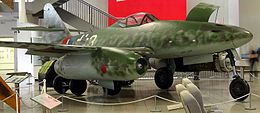
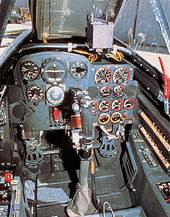
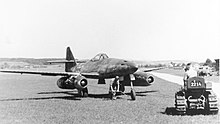

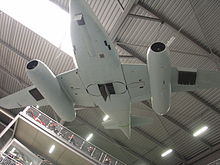


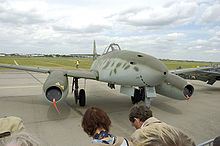
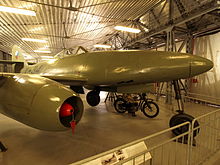
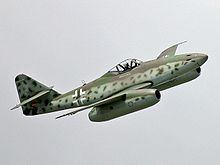



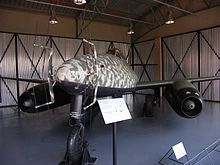



No comments:
Post a Comment